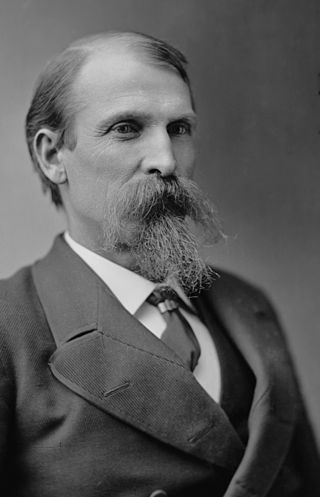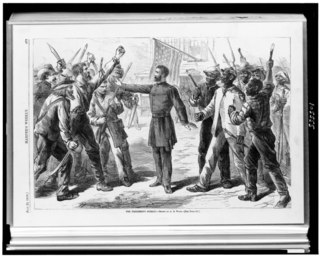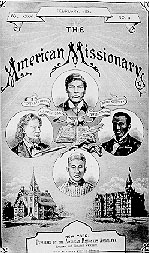
The Reconstruction era was a period in United States history and Southern United States history that followed the American Civil War and was dominated by the legal, social, and political challenges of the abolition of slavery and the reintegration of the eleven former Confederate States of America into the United States. During this period, three amendments were added to the United States Constitution to grant citizenship and equal civil rights to the newly freed slaves. To circumvent these legal achievements, the former Confederate states imposed poll taxes and literacy tests and engaged in terrorism to intimidate and control people of color and to discourage or prevent them from voting.

Isaac Murphy was a native of Pennsylvania, a teacher and lawyer who moved to Fayetteville, Arkansas with his wife and child in 1834. He continued to teach and also became active in politics. Murphy is best known as the only delegate to have repeatedly voted against secession at the second Arkansas Secession Convention in 1861.

Powell Foulk Clayton was an American politician, diplomat, and businessman who served as the 9th governor of Arkansas from 1868 to 1871, as a Republican United States Senator for Arkansas from 1871 to 1877 and as United States Ambassador to Mexico from 1897 to 1905.

The Brooks–Baxter War, also known as the Brooks–Baxter Affair, Arkansas Civil War, or the Second American Civil War was an attempt made by failed gubernatorial candidate Joseph Brooks of the “Brindle-tail” faction of Arkansas' Republican Party to take control of the state from Elisha Baxter, who was the Republican governor. The victor in the end was the Baxter administration, also known as the "Minstrels", supported by some "carpetbaggers" and Democrats over the Brindle-tails supported by "scalawags" and "freedmen".

The Bureau of Refugees, Freedmen, and Abandoned Lands, usually referred to as simply the Freedmen's Bureau, was a U.S. government agency of early post American Civil War Reconstruction, assisting freedmen in the South. It was established on March 3, 1865, and operated briefly as a federal agency after the War, from 1865 to 1872, to direct provisions, clothing, and fuel for the immediate and temporary shelter and supply of destitute and suffering refugees and freedmen and their wives and children.
The Battle of Poison Spring, also known as the Poison Spring massacre, was fought in Ouachita County, Arkansas, on April 18, 1864, as part of the Camden Expedition, during the American Civil War. A Union force commanded by Major General Frederick Steele had moved from Little Rock, Arkansas, in support of Major General Nathaniel Banks's movement along the Red River towards Shreveport, Louisiana. Steele's objective was also Shreveport, and his men occupied Camden, Arkansas. After Banks was defeated at the battles of Mansfield and Pleasant Hill, Steele was isolated in Arkansas. Short on supplies, Steele sent a detachment commanded by Colonel James M. Williams on April 17 to forage for 5,000 bushels of corn that were reported to be in the area.

The American Missionary Association (AMA) was a Protestant-based abolitionist group founded on September 3, 1846 in Albany, New York. The main purpose of the organization was abolition of slavery, education of African Americans, promotion of racial equality, and spreading Christian values. Its members and leaders were of both races; the Association was chiefly sponsored by the Congregationalist churches in New England. The main goals were to abolish slavery, provide education to African Americans, and promote racial equality for free Blacks. The AMA played a significant role in several key historical events and movements, including the Civil War, Reconstruction, and the Civil Rights Movement.

Contraband was a term commonly used in the US military during the American Civil War to describe a new status for certain people who escaped slavery or those who affiliated with Union forces. In August 1861, the Union Army and the US Congress determined that the US would no longer return people who escaped slavery who went to Union lines, but they would be classified as "contraband of war," or captured enemy property. They used many as laborers to support Union efforts and soon began to pay wages.
The Camden Expedition was the final campaign conducted by the Union Army in south Arkansas during the Civil War. The offensive was designed to cooperate with Major-General Nathaniel P. Banks' movement against Shreveport.

Mississippi was the second southern state to declare its secession from the United States, doing so on January 9, 1861. It joined with six other southern states to form the Confederacy on February 4, 1861. Mississippi's location along the lengthy Mississippi River made it strategically important to both the Union and the Confederacy; dozens of battles were fought in the state as armies repeatedly clashed near key towns and transportation nodes.

During the American Civil War, Arkansas was a Confederate state, though it had initially voted to remain in the Union. Following the capture of Fort Sumter in April 1861, Abraham Lincoln called for troops from every Union state to put down the rebellion, and Arkansas along with several other southern states seceded. For the rest of the civil war, Arkansas played a major role in controlling the Mississippi River, a major waterway.

This is a selected bibliography of the main scholarly books and articles of Reconstruction, the period after the American Civil War, 1863–1877.

The history of Arkansas began millennia ago when humans first crossed into North America. Many tribes used Arkansas as their hunting lands but the main tribe was the Quapaw, who settled in the Arkansas River delta upon moving south from Illinois. Early French explorers gave the territory its name, a corruption of Akansea, which is a phonetic spelling from the Illinois language word for the Quapaw. This phonetic heritage explains why "Arkansas" is pronounced so differently than the U.S. state of "Kansas" even though they share the same spelling.

Fort Southerland, also known as Redoubt E and possibly Fort Diamond, is a redoubt built during the American Civil War to protect Camden, Arkansas. Confederate forces built it along with four other redoubts in early 1864 after a Union victory in the Little Rock campaign the previous year. Fort Southerland is about the size of a city block and is roughly oval. It could hold three cannons. When Union forces captured Camden in April 1864 during the Camden Expedition, they improved the defenses of the five redoubts, which were not sufficient for proper defense of the city. After the Confederates retook Camden later that month, they continued to improve the city's defenses.
The Battle of Brownsville was fought on August 25, 1863, near what is now Lonoke, Arkansas, between Union forces led by Colonel Washington Geiger and Confederate troops under Brigadier General John S. Marmaduke. Union forces commanded by Major General Frederick Steele were advancing from Helena, Arkansas, towards Little Rock, the state capital of Arkansas. Confederate Major General Sterling Price ordered cavalry led by Marmaduke and Brigadier General Lucius M. Walker to Brownsville in response to the Union advance.

The 1st Missouri Field Battery was a field artillery battery that served in the Confederate States Army during the American Civil War. The battery was formed by Captain Westley F. Roberts in Arkansas in September 1862 as Roberts' Missouri Battery and was originally armed with two 12-pounder James rifles and two 6-pounder smoothbore guns. The unit fought in the Battle of Prairie Grove on December 7, as part of a Confederate offensive. Roberts' Battery withdrew after the battle and transferred to Little Rock, Arkansas, where Roberts resigned and was replaced by Lieutenant Samuel T. Ruffner.

African Americans have played an essential role in the history of Arkansas, but their role has often been marginalized as they confronted a society and polity controlled by white supremacists. As slaves in the United States, they were considered property and were subjected to the harsh conditions of forced labor. After the Civil War and the passage of the 13th, 14th, and 15th Reconstruction Amendments to the U.S. Constitution, African Americans gained their freedom and the right to vote. However, the rise of Jim Crow laws in the 1890s and early 1900s led to a period of segregation and discrimination that lasted into the 1960s. Most were farmers, working their own property or poor sharecroppers on white-owned land, or very poor day laborers. By World War I, there was steady emigration from farms to nearby cities such as Little Rock and Memphis, as well as to St. Louis and Chicago.
The Little Rock Campaign, officially known as Advance of the Union forces upon Little Rock, Arkansas, was a campaign conducted by the Union Army in Arkansas during the American Civil War. The strategic offensive was designed to capture Little Rock.

Freedmen's Schools were educational institutions created soon after the abolition of slavery in the United States to educate freedmen. Due to the remaining opposition to equality between blacks and whites, it was difficult for the formerly enslaved to receive a proper education, among a myriad of other things. Schools were made especially for blacks but were open to anyone regardless of race. These schools were far from perfect; however, they did give African Americans hope and opportunity for their future.

Edward W. Gantt was an American politician and Confederate soldier who defected to the Union during the American Civil War and was a Freedmen's Bureau agent during Reconstruction. Born in Maury County, Tennessee, in 1829, Gantt was a delegate to the 1850 Nashville Convention, which considered secession. Later in the decade, he moved to Arkansas, which he felt allowed him more opportunities to gain prominence. He spread secessionist rhetoric after the 1860 United States presidential election. He was elected to the United States House of Representatives but did not take his seat. After the outbreak of the American Civil War in 1861, Gantt became the colonel of the 12th Arkansas Infantry Regiment. He was wounded in an artillery duel while his regiment was in reserve at the Battle of Belmont, and in April 1862 was captured when the Confederate defenses of Island Number Ten fell.
















